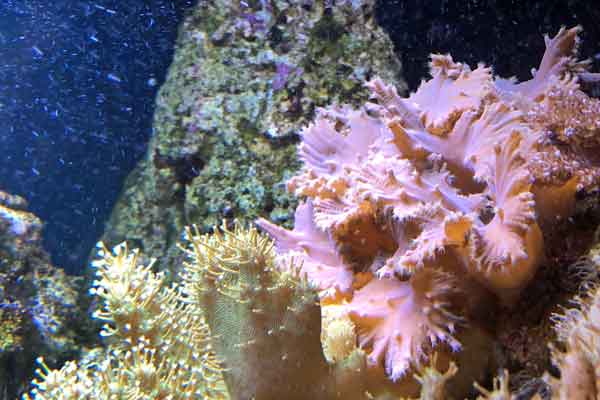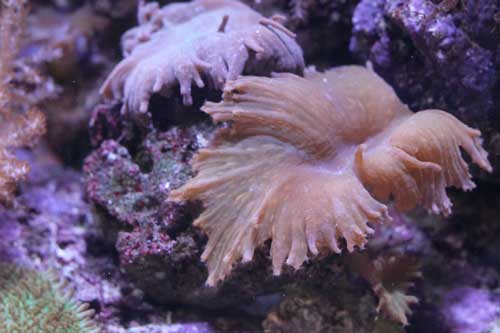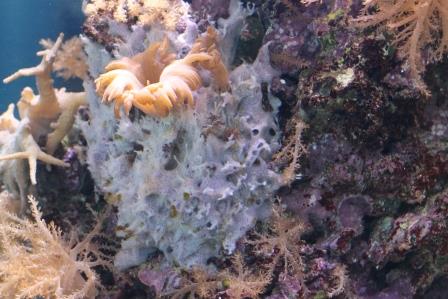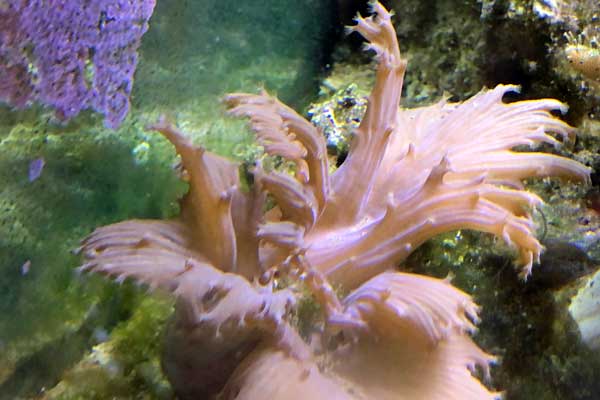[ad_1]
Sinularia dura, also known as the Cabbage Leather Coral, is a hardy soft coral that gets its common name because it grows on short stalks, close to the rock, with large fleshy lobes that are shaped somewhat like the leaves of a plant, like cabbage. The color is generally between pink and brown, although blue and neon green highlights are color morphs that are available.
Coloration in corals can change based on the specific lighting configuration they are kept under.
Let’s dive deeper into the world of Sinularia dura, the Cabbage Leather Coral.
Care requirements in a saltwater aquarium
Typical aquarium conditions are all that the cabbage leather coral needs to thrive.
- Recommended temperature: 73-84 degrees Fahrenheit, 22.8 to 28.9 Celcius (stable, not fluctuating)
- Specific gravity: 1.025
- Lighting: Low to moderate
- Water flow: Low to moderate
- pH: ~8.1- 8.4 (stable, not fluctuating)
- Harness: 8-12 (again, stable, not changing frequently)
This is just a brief overview of the appropriate water parameters. For a more in-depth look, check out this article:
The 9 most important reef tank water parameters
Unlike the polyps from some other leather corals, like the toadstool leather coral, the small polyps of Sinularia dura are able to capture prey and would benefit from the occasional feeding of Reef Roids, baby brine shrimp, or cyclops.
Natural habitat
The natural range for the cabbage leather coral is widespread throughout the Indian and Pacific Oceans and the Red Sea, often in shallow water reef areas with strong currents, in which this soft coral thrives, because it has a relatively tough body and a lot of bony sclerites for support.

Take a look at this toxic mix–palytoxin producing palythoa and a terpene toting great cabbage patch
Compatibility
The cabbage leather coral is probably best kept with other leather corals, as well as zoanthid, and mushroom coral species. Sinularia coral is known to be the most toxic of the leather coral species.
According to Borneman, there are reports that Sinularia species (not always the cabbage leather coral) inhibit or stunt the growth of stony corals, including Catalaphyllia, Euphyllia, Plerogyra, etc.).
While the Borneman book, Aquarium Corals, highlights Sinularia flexibilis as the most toxic from this group, citing the release of terpenes, I would encourage caution in selecting this coral in conjunction with LPS or SPS corals, although I have personally had success keeping them along with the Frogspawn coral, there is enough out there about the incompatibility that caution is certainly advised.
Reproduction and propagation

This sinularia coral was easy to frag
These corals are thought to reproduce by fragmentation or branch dropping, as well as having larger branches divide in two. They are not particularly fast-growing leather corals, but they do frag quite easily.
Frags are best attached to the substrate using a rubber band or plastic mesh methods, which are described in greater detail in, How to Frag Corals.

Attachment of leather corals, like this Sinularia, can be tricky. The rubber band method ought to do the trick
If you want to learn more about propagating Sinularia coral and others, check out this how-to guide first.
Scientific name
The scientific name for the cabbage leather coral is Sinularia dura. The cabbage leather coral has relatively small polyps that are able to capture prey. Sinularia dura is an octocoral, meaning that each polyp has 8 tentacles.
Other common names
You may see cabbage leather corals, sinularia dura, listed under one of these other common names: carpet coral, flower leather coral, flat leather coral, leaf leather coral, lobed leather coral, scalloped leather coral.
All soft coral have bony structures, call sclerites, in their bodies–they look like tiny bony fingernail clippings. These structures provide basic support for the body of the coral and can often be seen inside the flesh of these corals, as you can see in the image below.
Where to buy
Cabbage leather corals are a popular species and are available at most local and online aquarium stores. Since they are easy to frag, you may be able to save some money by trading for a frag or buying a frag from a fellow hobbyist in your area. Joining an aquarium club is a great way to meet other hobbyists and trade frags.

Take a look at the great neon green coloration of this Cabbage leather coral, Sinularia dura
For more information
Check out other great soft coral species:
If you’re looking for a great beginner coral, check out this article.
For more information about setting up a new saltwater aquarium with a great beginner coral, like the cabbage leather coral, check out The New Saltwater Aquarium Guide.
To learn tips and techniques to start fragging your own corals, check out How to Frag Corals.
References
Borneman, Eric H. Aquarium Corals. Microcosm Ltd; 1st Printing Edition (March 1, 2001)
Ulrich III, Albert B. How to Frag Corals: Step-by-step guide to coral propagation and filling your frag tank with thriving polyps. www.SaltwaterAquariumBlog.com (January 20, 2015).
Ulrich III, Albert B. The New Saltwater Aquarium Guide.www.SaltwaterAquariumBlog.com (April 8, 2014)
[ad_2]
Source link




